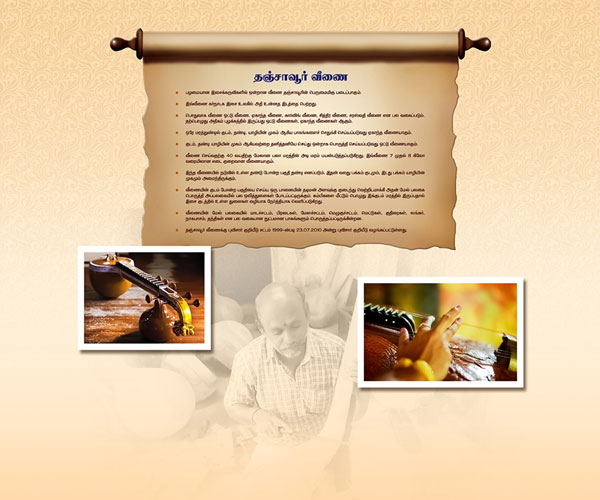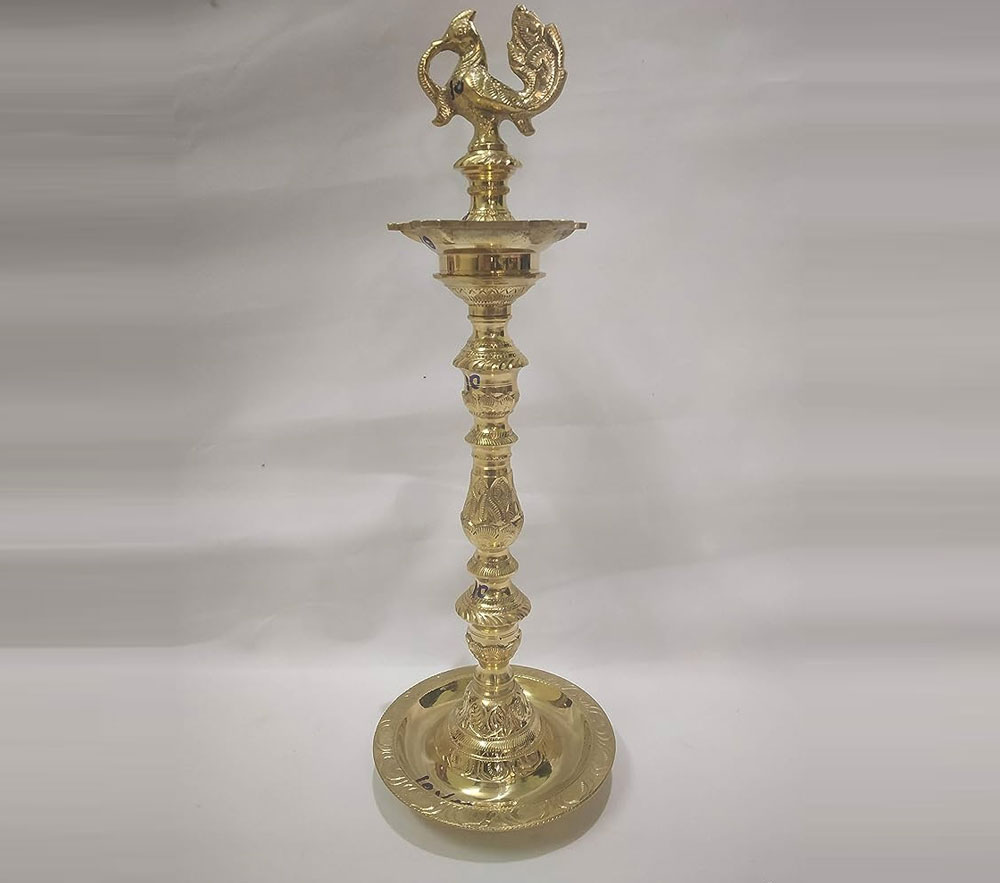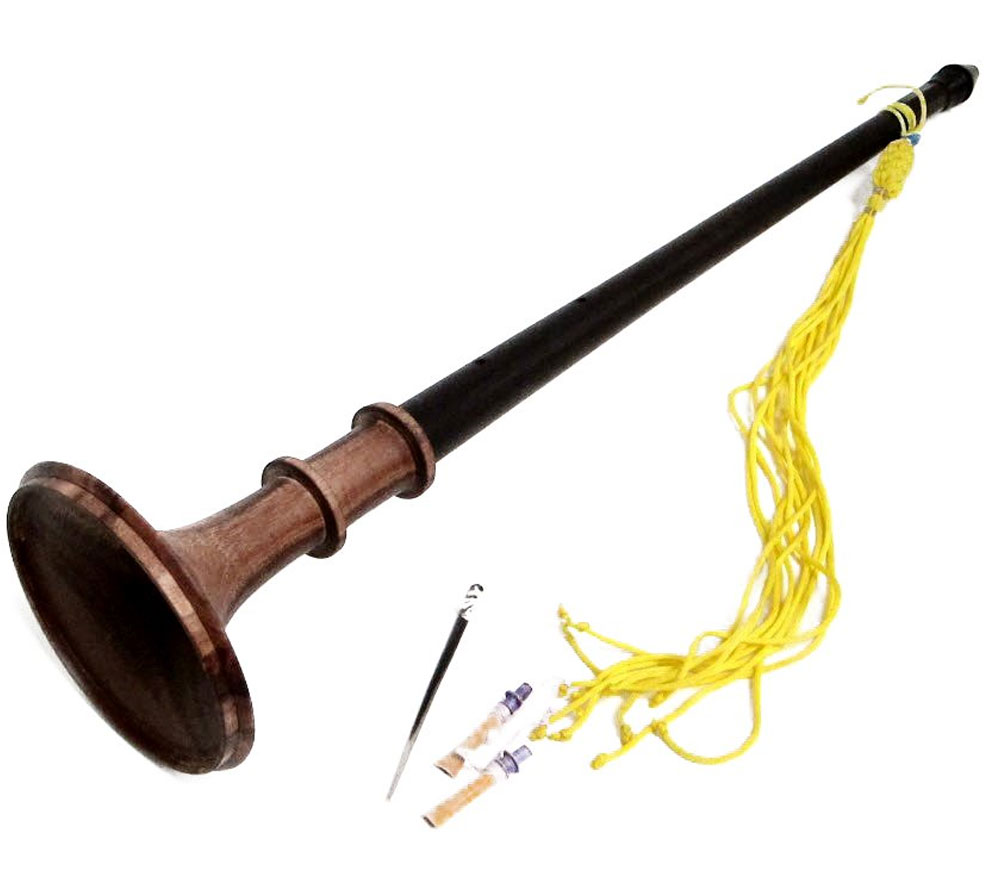
Among Thanjavur dolls, dolls with moving heads are called head dolls. Talking dolls are called by many names like grandparent doll, Chettiar Chettiachi doll. This toy is native to Thanjavur. However, this toy is different from the Thanjavur Gunduchatti toy, which has been given a geographical indication by the Tamil Nadu government.
These dolls and dancing dolls are different. The head, body and waist part of the dance dolls all move separately. But only the head is made to move in dolls. In these dolls, the body is made bigger and heavier. The headpiece is lightweight and lightweight. Due to this, only the head is moving in the wind.
Among the traditional arts of Thanjavur artists, it is an art that has been shared by the states of Tamil Nadu and Karnataka. These paintings are pasted on wooden boards and embellished using beaten gold leaf and sometimes semi-precious stones.The origin of this art dates back to the 11th century Chola temple wall paintings. However, the art flourished under the rule of the Nayaks under the rule of the Vijayanagara Empire. Thanjavur Nayaks were great patrons of art and music. It was with this patronage that artists were established in the neighboring states of Madurai and Thanjavur. It was this Thanjavur style that gave way to the present style of Thanjavur paintings under Maratha rule.The Marathas, being patrons of the arts, encouraged Thanjavur artists. The fusion of Maratha style with local art eventually gave way to the modern Tanjore style.This art school is very inspired by the European schools of art and has a clear palette of colors like red, yellow, deep green, gold leaf and white like glass beads. Unlike other Indian painting styles, these are large in scale and contain a variety of subjects with very simple compositions.Earlier artist used only colors obtained from natural sources but nowadays they use chemical based colors as well.


This harp was first made in the 17th century during the reign of Thanjavur king Iragunath. That is why Thanjavur Veena is known as Iragunatha Veena. The Thanjavur veena is made of jack and vagai trees. However, the jack wood itself is easy to carve and thread when making the Veena. Palamaras are procured from panruti. Because the soil of Panruti is suitable for growing jackfruit, jackfruit is grown there. Even if jackfruit is available in the nearby villages, they buy it and make Veena. Veenas kept in museums can be known that different shapes of veenas like fish, lapel, boat etc. have been made. Men do the hard work of making kudam, thandi and yali head. About 15 years ago, they used to weave deer horns and attach them to jugs and stems to make floral designs. At present modern industry is doing fine engravings so they are making flower engravings on plastic card.
Thanjavur pith work is famous for miniature works of Thanjavur temples and idol making. The finished pith work is generally fixed to a wooden base and covered with glass to protect from dust and moisture. This helps to preserve the works for years. For normal pieces ply wood made stands are used as base, whereas for big and important pieces teak and wood stands are used. Miniatures of rural and urban place are also made, which are decorated with lights. The art pieces made of pith starts at the range of fifty rupees and goes up to lakh.
The carved pieces are assembled together and stuck with adhesive into one piece of art. Blue prints of the design or photos are used as reference to make the miniatures. It takes one day to make small figures whereas10 to 12 days to finish a detailed designed big Ganesha idol. It takes almost a month to finish set of art piece of a place or temple. Sometimes customers send the reference of the art piece they want to be made. Some pith works are painted with water colors to make it look colorful and attractive.


Thanjavur Art Plate, Thanjavur Art Plate, Thanjavur Art Plate or Thanjavur Art Plate is an artificial decorative object created in Thanjavur. This round plate is made as a gift item. This craft is carved out of metals like silver, brass, copper, with embossed pictorial work with figures of Gods or Devas in the middle. This artistic work is registered under the Agreement on Commercial Aspects of Intellectual Property Rights for Geographical Indication Protection. It is listed as the 63rd object of the Government of India’s Geographical Indices Act 1999 as the “Thanjavur Art Plate”. Just like the Thanjavur Veena, the Thanjavur Kalaithat also expresses the pride of Thanjavur.
Swamimala near Kumbakonam is the world famous place for panchaloka sculptures. Sculptors living in this area are descendants of Chola era sculptors.
Grandfather Rajarajacholan built the big temple of Thanjavur by bringing sculptors from many towns. Later he built Tarasuram temple near Kumbakonam in Tanjore district with these sculptures. Later, sculptors migrated to the area for tirupani at the Swamimalai temple. After completing the restoration work, some families stayed there as the alluvial soil found in the Cauvery river basin was suitable for making Panchaloka sculptures.Sculptors also knew stone work, wood work, panchaloka work and temple construction work. They started producing panchaloka sculptures as Swamimalai clay was suitable for making panchaloka sculptures.Its ornamentation, carving and texture are very important for Panchaloka sculptures in general. Among these, the facial structure is similar to the way one’s handwriting is structured, which is the facial structure sculpted by sculptors. It can be said that some of the facial structure is angry and calm.This industry can only be done in the traditional way but not in the new way. Copper-80%, silver, lead, gold, silver, composite-20% is the traditional method of making a wax pattern by drying it with river sediment and then taking the wax and making a mold.


Nachiarkoil lamp, also known as Amman lamp or Nachiarkoil lamp, is a decorative lamp made of brass by stacking Akal lamps. It is made exclusively by the Kammalar (Pattar) community in Nachiarkoil, a temple town in Tamil Nadu, India. The lamp, which is a hollow cast, is made in four parts of different sizes. The lamp, which is a hollow cast, is made in four parts of different sizes. Then, they are screwed together. A crown-like structure called “Prabhai” is fixed on its top. It is usually in the form of a feature bird or a swan. The lamp can be made in the form of a female figure holding a shallow bowl or in the form of a tree branch.The bowl of these lamps has five English V-shaped arrangement. They are filled with oil and lit with cotton wicks. These types of decorative lamps are widely used in temples in South India.
From the middle-class family to the affluent in Tamil Nadu, buying Thiruphuvanam silk cloths is considered to be an auspicious and auspicious thing. In Thanjavur district, since the time of the Chola kings, silk sarees have been produced in Thiruphuvana with traditional handloom designs. Tiruphuvanam silk is unique because of the title of the silk sarees, the beautiful designs on the edges, and the lace work that attracts everyone. The people of Saurashtra, known as Pattu Nualkars, have been engaged in silk weaving.They excel in weaving silk fabrics in many designs from original silk lace and twisted silk. Although various cities in the world are specialized in weaving silk fabrics, Tirupuram silk has its own specialty.


Kalamkari cloth painting is a painting done on cloth with herbal dyes in Tanjore embankment areas since 17th century AD. Kalamkari painting is painting on cloth. Mainly in this the painting of God, temples. The painting mainly includes painting of Tanjore Great Temple, painting representing our traditional customs, painting representing our history etc. The paintings are as old as they are contemporary. Invariably it is drawn according to the wishes of the people of this age. These were first used in temples at that time as 50, 60 feet of cloth. Festivals were also used in those days, festivals were held in the temple every month. This kalamkari painting will feature several feet high cloths used then. Nowadays these paintings are featured in sarees, bed sheets etc.
“In the Thanjavur district, which is the cultural capital of South India and the stronghold of Sangeets, the musical instrument called Nathaswaram has been used since the 17th century. Prior to 1955, Thai ragas were played only with “Prathi Madhyam Swaram”. Later, in 1955, a craftsman named Ranganatha Achari of Narasinghampet village, Thanjavur district, discovered the “Suddha Madhyam Swara” in Nathasvaram and created it on Natasvaram instrument. This instrument was easy to play. This is why Narasingampet got its name as Nathaswaram. This instrument greatly helped in the development of natasvara music. At present this nataswaram instrument is recognized in 158 countries.

The Thanjavur Tourism Promotion Council has launched a WhatsApp Channel specifically for Thanjavur Tourism. Kindly invite your friends interested in exploring Tourism & Heritage to join us. Let’s contribute to the promotion of Thanjavur Tourism together!
Copyright © 2023 Thanjavur Tourism Promotion Council. Developed & Hosted by YOGA’S IT Solutions.